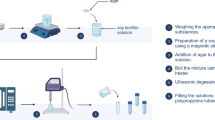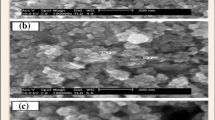Abstract
Objective
To develop a robust amine chemical exchange saturation transfer (CEST) physical phantom, validate the temporal stability, and create a supporting software for automatic image processing and quality assurance.
Materials and methods
The phantom was designed as an assembled laser-cut acrylic rack and 18 vials of phantom solutions, prepared with different pHs, glycine concentrations, and gadolinium concentrations. We evaluated glycine concentrations using ultraviolet absorbance for 70 days and measured the pH, relaxation rates, and CEST contrast for 94 days after preparation. We used Spearman’s correlation to determine if glycine degraded over time. Linear regression and Bland–Altman analysis were performed between baseline and follow-up measurements of pH and MRI properties.
Results
No degradation of glycine was observed (p > 0.05). The pH and MRI measurements stayed stable for 3 months and showed high consistency across time points (R2 = 1.00 for pH, R1, R2, and CEST contrast), which was further validated by the Bland–Altman plots. Examples of automatically generated reports are provided.
Discussion
We designed a physical phantom for amine CEST-MRI, which is easy to assemble and transfer, holds 18 different solutions, and has excellent short-term chemical and MRI stability. We believe this robust phantom will facilitate the development of novel sequences and cross-scanners validations.







Similar content being viewed by others
Data availability
The CAD files used for creating the physical phantom components are available on (Github website: https://github.com/Jingwen-Yao/CEST_physical_phantom). MATLAB code of the automatic quality assurance software, and the accompanying template data used in this study are available on (Github website: https://github.com/Jingwen-Yao/CEST_physical_phantom).
References
Vinogradov E, Sherry AD, Lenkinski RE (2013) CEST: from basic principles to applications, challenges and opportunities. J Magn Reson 229:155–172
van Zijl PCM, Yadav NN (2011) Chemical exchange saturation transfer (CEST): what is in a name and what isn’t? Magn Reson Med 65(4):927–948
Ling W, Regatte RR, Navon G, Jerschow A (2008) Assessment of glycosaminoglycan concentration in vivo by chemical exchange-dependent saturation transfer (gagCEST). P Natl Acad Sci USA 105(7):2266–2270
Zaiss M, Anemone A, Goerke S, Longo DL, Herz K, Pohmann R, Aime S, Rivlin M, Navon G, Golay X, Scheffler K (2019) Quantification of hydroxyl exchange of d-Glucose at physiological conditions for optimization of glucoCEST MRI at 3, 7 and 9.4 Tesla. NMR Biomed 32(9):4113
Nasrallah FA, Pages G, Kuchel PW, Golay X, Chuang KH (2013) Imaging brain deoxyglucose uptake and metabolism by glucoCEST MRI. J Cerebr Blood Flow Metab 33(8):1270–1278
Xu X, Yadav NN, Knutsson L, Hua J, Kalyani R, Hall E, Laterra J, Blakeley J, Strowd R, Pomper M, Barker P, Chan K, Liu G, McMahon MT, Stevens RD, van Zijl PC (2015) Dynamic glucose-enhanced (DGE) MRI: translation to human scanning and first results in glioma patients. Tomography 1(2):105–114
Xu X, Chan KWY, Knutsson L, Artemov D, Xu JD, Liu G, Kato Y, Lal B, Laterra J, McMahon MT, van Zijl PCM (2015) Dynamic glucose enhanced (DGE) MRI for combined imaging of blood–brain barrier break down and increased blood volume in brain cancer. Magn Reson Med 74(6):1556–1563
Cai KJ, Haris M, Singh A, Kogan F, Greenberg JH, Hariharan H, Detre JA, Reddy R (2012) Magnetic resonance imaging of glutamate. Nat Med 18(2):302–306
Cai KJ, Singh A, Roalf DR, Nanga RPR, Haris M, Hariharan H, Gur R, Reddy R (2013) Mapping glutamate in subcortical brain structures using high-resolution GluCEST MRI. NMR Biomed 26(10):1278–1284
Harris RJ, Cloughesy TF, Liau LM, Nghiemphu PL, Lai A, Pope WB, Ellingson BM (2016) Simulation, phantom validation, and clinical evaluation of fast pH-weighted molecular imaging using amine chemical exchange saturation transfer echo planar imaging (CEST-EPI) in glioma at 3 T. NMR Biomed 29(11):1563–1576
Yao J, Chakhoyan A, Nathanson DA, Yong WH, Salamon N, Raymond C, Mareninov S, Lai A, Nghiemphu PL, Prins RM, Pope WB, Everson RG, Liau LM, Cloughesy TF, Ellingson BM (2019) Metabolic characterization of human IDH mutant and wild type gliomas using simultaneous pH- and oxygen-sensitive molecular MRI. Neuro Oncol. https://doi.org/10.1093/neuonc/noz078
Kogan F, Haris M, Singh A, Cai KJ, Debrosse C, Nanga RPR, Hariharan H, Reddy R (2014) Method for high-resolution imaging of creatine in vivo using chemical exchange saturation transfer. Magn Reson Med 71(1):164–172
Kogan F, Haris M, Debrosse C, Singh A, Nanga RP, Cai K, Hariharan H, Reddy R (2014) In vivo chemical exchange saturation transfer imaging of creatine (CrCEST) in skeletal muscle at 3T. J Magn Reson Imaging 40(3):596–602
Zhou J, Payen J-F, Wilson DA, Traystman RJ, van Zijl PC (2003) Using the amide proton signals of intracellular proteins and peptides to detect pH effects in MRI. Nat Med 9(8):1085
Zhou J, Lal B, Wilson DA, Laterra J, van Zijl PC (2003) Amide proton transfer (APT) contrast for imaging of brain tumors. Magn Reson Med 50(6):1120–1126
Zhou JY, Blakeley JO, Hua J, Kim M, Laterra J, Pomper MG, van Zijl PCM (2008) Practical data acquisition method for human brain tumor amide proton transfer (APT) imaging. Magn Reson Med 60(4):842–849
Paech D, Windschuh J, Oberhollenzer J, Dreher C, Sahm F, Meissner JE, Goerke S, Schuenke P, Zaiss M, Regnery S, Bickelhaupt S, Baumer P, Bendszus M, Wick W, Unterberg A, Bachert P, Ladd ME, Schlemmer HP, Radbruch A (2018) Assessing the predictability of IDH mutation and MGMT methylation status in glioma patients using relaxation-compensated multipool CEST MRI at 7.0 T. Neuro Oncol 20(12):1661–1671
Sun PZ, Cheung JS, Wang E, Lo EH (2011) Association between pH-weighted endogenous amide proton chemical exchange saturation transfer MRI and tissue lactic acidosis during acute ischemic stroke. J Cereb Blood Flow Metab 31(8):1743–1750
Yan K, Fu ZM, Yang C, Zhang K, Jiang SS, Lee DH, Heo HY, Zhang Y, Cole RN, Van Eyk JE, Zhou JY (2015) Assessing amide proton transfer (APT) MRI contrast origins in 9 L gliosarcoma in the rat brain using proteomic analysis. Mol Imaging Biol 17(4):479–487
Jones KM, Pollard AC, Pagel MD (2018) Clinical applications of chemical exchange saturation transfer (CEST) MRI. J Magn Reson Imaging 47(1):11–27
Harris RJ, Yao J, Chakhoyan A, Raymond C, Leu K, Liau LM, Nghiemphu PL, Lai A, Salamon N, Pope WB, Cloughesy TF, Ellingson BM (2018) Simultaneous pH-sensitive and oxygen-sensitive MRI of human gliomas at 3 T using multi-echo amine proton chemical exchange saturation transfer spin-and-gradient echo echo-planar imaging (CEST-SAGE-EPI). Magn Reson Med 80(5):1962–1978
Longo DL, Busato A, Lanzardo S, Antico F, Aime S (2013) Imaging the pH evolution of an acute kidney injury model by means of iopamidol, a MRI-CEST pH-responsive contrast agent. Magn Reson Med 70(3):859–864
Wapler MC, Leupold J, Dragonu J, von Elverfeld D, Zaitsev M, Wallrabe U (2014) Magnetic properties of materials for MR engineering, micro-MR and beyond. J Magn Reson 242:233–242
Maddah HA (2016) Polypropylene as a promising plastic: a review. Am J Polym Sci 6(1):1–11
Oh JH, Kim HG, Woo DC, Jeong HK, Lee SY, Jahng GH (2017) Chemical-exchange-saturation-transfer magnetic resonance imaging to map gamma-aminobutyric acid, glutamate, myoinositol, glycine, and asparagine: phantom experiments. J Korean Phys Soc 70(5):545–553
Chung S, Kim D, Breton E, Axel L (2010) Rapid B-1(+) mapping using a preconditioning RF pulse with TurboFLASH readout. Magn Reson Med 64(2):439–446
Yao J, Ruan D, Raymond C, Liau LM, Salamon N, Pope WB, Nghiemphu PL, Lai A, Cloughesy TF, Ellingson BM (2018) Improving B0 correction for pH-weighted amine proton chemical exchange saturation transfer (CEST) imaging by use of k-means clustering and lorentzian estimation. Tomography 4(3):123–137
Mcconnell JS, Mcconnell RM, Hossner LR (1993) Ultraviolet-spectra of acetic-acid, glycine, and glyphosate. Proc Ark Acad Sci 47(1993):73–76
Schuenke P, Windschuh J, Roeloffs V, Ladd ME, Bachert P, Zaiss M (2017) Simultaneous mapping of water shift and B1 (WASABI)-application to field-inhomogeneity correction of CEST MRI data. Magn Reson Med 77(2):571–580
Zaiss M, Windschuh J, Paech D, Meissner JE, Burth S, Schmitt B, Kickingereder P, Wiestler B, Wick W, Bendszus M, Schlemmer HP, Ladd ME, Bachert P, Radbruch A (2015) Relaxation-compensated CEST-MRI of the human brain at 7T: Unbiased insight into NOE and amide signal changes in human glioblastoma. Neuroimage 112:180–188
Acknowledgements
We thank the UCLA Bioengineering department to coordinate the undergraduate Capstone senior design projects and provide the mechanical workspace. We would like to acknowledge Dr. Stephanie Seidlits, teaching assistants Jonathan Massachi and Michael Bogumil, for supporting the Capstone project.
Funding
This study was funded by American Cancer Society (ACS) Research Scholar Grant (RSG-15–003-01-CCE), UCLA SPORE in Brain Cancer (NIH/NCI 1P50CA211015-01A1), and NIH/NCI (1R21CA223757-01).
Author information
Authors and Affiliations
Contributions
Conceptualization: JY, CRG, BME; methodology: XC, ANL, HD; data acquisition: JY, CW, XC, KD, MWJL; data analysis: JY, BB, ZSK, JANP, JDP, SSR; writing—original draft preparation: JY; Writing—review and editing: BME; funding acquisition: BME; resources: DAN; supervision: BME.
Corresponding author
Ethics declarations
Conflict of interest
Author B.M.E. is a paid consultant at companies Medicenna, MedQIA, Neosoma, Agios Pharmaceuticals, Siemens, Imaging Endpoints, Kazia/Novogen, and NW Biopharmaceuticals. He is a consultant at companies Oncoceutics, BeiGene, BBI, Tocagen, and non-profit organizations Global Coalition for Adaptive Research (GCAR) and NIH/NCI Cancer Imaging Steering Committee. Author B.M.E. also receives research grant from companies Siemens, Janssen Pharmaceuticals, VBL, and non-profit organizations National Brain Tumor Society and ACS. Author D.A.N. is a co-founder and consultant at company Katmai Pharmaceuticals and a co-founder of company Trethera Corporation. He is also a shareholder in Sofie Biosciences. Authors J.Y., C.R.G., X.C., A.N.L., H.D., C.W., K.D., M.W.J.L, B.B., Z.S.K., J.A.N.P., J.D.P., S.S.R. has no conflict of interest to disclose.
Ethical approval
This article does not contain any studies with human participants or animals performed by any of the authors.
Additional information
Publisher's Note
Springer Nature remains neutral with regard to jurisdictional claims in published maps and institutional affiliations.
Supplementary Information
Below is the link to the electronic supplementary material.
Rights and permissions
About this article
Cite this article
Yao, J., Wang, C., Raymond, C. et al. A physical phantom for amine chemical exchange saturation transfer (CEST) MRI. Magn Reson Mater Phy 34, 569–580 (2021). https://doi.org/10.1007/s10334-020-00902-z
Received:
Revised:
Accepted:
Published:
Issue Date:
DOI: https://doi.org/10.1007/s10334-020-00902-z




